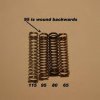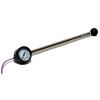Frank_Hassa
Member
I've read several threads about pop-off testers on this forum and another one that supposedly gives directions on how to build one, but none of it is gelling in my head and I have more questions now after I've done all this reading and youtube watching than I had when I started.
First, can someone please explain both the pop-off testing procedure and also what function it's supposed to test. From what I've read, it has something to do with the pressure at which some part of the carburetor either admits or restricts fuel into the engine and I don't know which and I don't know why, and I don't know why this "pressurizing" "on/off" is function is necessary because to my knowledge lawn mower carbs and automotive/truck carbs do not have this function, and I wonder if there's something unique about boats that requires it? And also if this pressure dynamic might have something to do with a "fuel return line" which also seems odd and unfamiliar in terms of "method" of fuel delivery. So if someone could give a "big picture" description of how the whole thing fits together and why, I'd appreciate it.
Also in terms of the test procedure itself, I'm confused, mostly I think because I don't understand the "big picture" mentioned above, and so maybe if I understood that, the references I've seen to the test procedure/method might make more sense.
Finally the home made test kit. I read a "how to" thread on another forum but the writing clarity was so poor I didn't understand a thing about how to build one. And again, maybe if I understood the whole thing better, building one might seem more self-explanatory. I understand that a gauge is needed, so I wonder if the gauge I plan on purchasing for the compression testing can also be used for the home-built pop-off tester.
Here's the gauge I'm going to buy:
https://www.walmart.com/ip/Equus-3612-Innova-Compression-Tester/14644667
Will this also work for the pop-off tester, and if so, what other pieces and parts do I need?
First, can someone please explain both the pop-off testing procedure and also what function it's supposed to test. From what I've read, it has something to do with the pressure at which some part of the carburetor either admits or restricts fuel into the engine and I don't know which and I don't know why, and I don't know why this "pressurizing" "on/off" is function is necessary because to my knowledge lawn mower carbs and automotive/truck carbs do not have this function, and I wonder if there's something unique about boats that requires it? And also if this pressure dynamic might have something to do with a "fuel return line" which also seems odd and unfamiliar in terms of "method" of fuel delivery. So if someone could give a "big picture" description of how the whole thing fits together and why, I'd appreciate it.
Also in terms of the test procedure itself, I'm confused, mostly I think because I don't understand the "big picture" mentioned above, and so maybe if I understood that, the references I've seen to the test procedure/method might make more sense.
Finally the home made test kit. I read a "how to" thread on another forum but the writing clarity was so poor I didn't understand a thing about how to build one. And again, maybe if I understood the whole thing better, building one might seem more self-explanatory. I understand that a gauge is needed, so I wonder if the gauge I plan on purchasing for the compression testing can also be used for the home-built pop-off tester.
Here's the gauge I'm going to buy:
https://www.walmart.com/ip/Equus-3612-Innova-Compression-Tester/14644667
Will this also work for the pop-off tester, and if so, what other pieces and parts do I need?
Last edited by a moderator:





